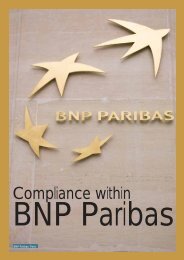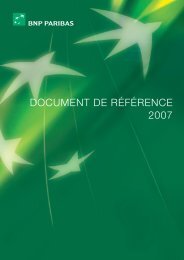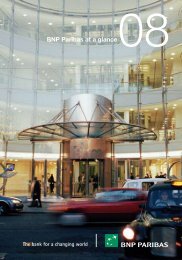2007 REGISTRATION DOCUMENT
2007 REGISTRATION DOCUMENT
2007 REGISTRATION DOCUMENT
- No tags were found...
Create successful ePaper yourself
Turn your PDF publications into a flip-book with our unique Google optimized e-Paper software.
5 NotesCONSOLIDATED FINANCIAL STATEMENTSto the financial s tatements p repared in accordance with I nternational Financial Reporting S tandards as adopted by the European UnionActual effectiveness is assessed on an ex-post basis by ensuring thatthe monthly change in the fair value of hedged items since the start ofthe month does not indicate any over-hedging.Cash flow hedgesIn terms of interest rate risk, the Group uses derivative instrumentsto hedge fluctuations in income and expenses arising on floating-rateassets and liabilities. Highly probable forecast transactions are alsohedged. Hedged items are split into maturity bands by currency andbenchmark interest rate. After factoring in prepayment assumptions andestimated default rates, the Group uses derivatives to hedge some or allof the risk exposure generated by these floating-rate instruments.< Contents >In terms of currency risk, the Group hedges against variability incomponents of consolidated earnings. In particular, the Group mayhedge future revenue flows (especially interest and fee/commissionincome) derived from operations carried out by its main subsidiariesand/or branches in a currency other than their functional currencies. Asin the case of interest rate hedges, the effectiveness of these hedgingrelationships is documented and assessed on the basis of forecastmaturity bands.The table below shows the amount of hedged future cash flows, splitby forecast date of realisation:12In millions of euros 31 December <strong>2007</strong> 31 December 2006Period to realisationLess than1 year1 to5 yearsMore than5 years TotalLess than1 year1 to5 yearsMore than5 years TotalHedged cash flows 1,042 2,080 3,445 6,567 657 1,988 2,720 5,365In the year ended 31 December <strong>2007</strong>, no hedges of forecast transactions were requalified as ineligible for hedge accounting on the grounds that therelated future event would be no longer highly probable.344.d LIQUIDITY AND REFINANCING RISKLiquidity and refinancing risk is the risk of the Bank being unable to fulfilcurrent or future foreseen or unforeseen cash or collateral requirementswithout affecting routine transactions or its financial position.Liquidity and refinancing risk is managed through a global liquiditypolicy approved by Group Executive Management. This policy is basedon management principles designed to apply both in normal conditionsand in a liquidity crisis. The Group’s liquidity position is assessed on thebasis of internal standards, warning flags and regulatory ratios.4.d.1Liquidity r isk m anagement p olicyObjectivesThe objectives of the Group’s liquidity management policy are to (i)secure a balanced financing mix to support BNP Paribas’ developmentstrategy; (ii) ensure that the Group is always in a position to dischargeits obligations to its customers; (iii) ensure that it does not trigger asystemic crisis solely by its own actions; (iv) comply with the standardsset by the local banking supervisor; (v) keep the cost of refinancing aslow as possible; and (vi) cope with any liquidity crises.Roles and responsibilities in liquidity riskmanagementThe ALM-CIB Committee, acting on recommendations from ALM-Treasury, reviews and approves the general principles of the liquiditypolicy. The Committee is informed on a regular basis of liquidity indicatorsand the results of stress tests, as well as of the execution of financingprogrammes. It is also informed of any crisis situation, and is responsiblefor deciding on the allocation of crisis management roles and approvingemergency plans.ALM-Treasury draws up and recommends the general principles ofthe liquidity policy. Once these have been approved by the ALM-CIBCommittee, ALM-Treasury is responsible for implementing the policy atboth central and individual entity level. It is also owner of the systemsused to manage liquidity risk.The business line ALM committees and local ALM committees implementat local level the strategy approved by the ALM-CIB Committee.GRM contributes to defining liquidity policy principles and exercisesoversight of the related models, risk indicators, limits and marketparameters, as well as performing liquidity stress tests.Centralised liquidity risk managementLiquidity risk is managed centrally by ALM-Treasury across allmaturities.The Treasury unit is responsible for refinancing and for short-termissues (certificates of deposit, commercial paper, etc), while the ALMunit is responsible for senior and subordinated debt issues (MTNs, bonds,medium/long-term deposits, covered bonds, etc), preferred share issues,and loan securitisation programmes for the retail banking business andthe financing business lines within Corporate and Investment Banking.ALM-Treasury is also tasked with providing financing to the Group’s corebusinesses and business lines, and investing their surplus cash.4.d.2Liquidity r isk m anagementand s upervisionDay-to-day liquidity management is based on a full range of internalstandards and warning flags at various maturities.■ An overnight target is set for each Treasury unit, limiting the amountraised on interbank overnight markets. This applies to the majorcurrencies in which the Group does business.■ The refinancing capacity needed to cope with an unexpected surgein liquidity needs is regularly measured at Group level. It mainlycomprises available securities and loans eligible for central bankrefinancing, available ineligible securities that can be sold underrepurchase agreements or immediately on the market, and overnightloans not liable to be renewed.■ BNP Paribas uses indicators to monitor the diversification of its sourcesof short-term funds on a worldwide basis to ensure that it is not overdependenton a limited number of providers of capital.567891011148<strong>2007</strong> Registration document - BNP PARIBAS
















